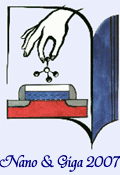
From Atoms to Materials to Devices to System Architecture
Symposium and Spring School (Tutorial Lectures)
Phoenix, Arizona, March 12-16, 2007

 |
Nano and Giga Challenges in Electronics and Photonics From Atoms to Materials to Devices to System Architecture Symposium and Spring School (Tutorial Lectures) Phoenix, Arizona, March 12-16, 2007 |
 |
|
|
Commentary
As science and technology approaches new frontiers by controlling functionality of materials at atomic scale, costs of experiments increase sharply. Consequently computational modeling gains high importance, since in many cases it offers a far less expensive alternative and fundamental insight as well. The success of computational materials science in its capability to address and to solve complex technological problems depends on how reliable the models are and how much the computations cost in terms of computer resources. While methods based on first-principles perform well in the first respect, they are limited in application to systems of 1-2 nanometers in size and a time scale of a few picoseconds. Our recently organized Bremen Center of Computational Materials Science, carries out application oriented modeling by means of first-principles methods but also of a very efficient, high speed semi-empirical method, which has been proven to be reliable in solving different complex problems such as improvement of the properties of surface coatings (wear, wetting, etc.), polymer-ceramics adhesion, semiconductor engineering and photocycles in functional biomolecular systems. In the density-functional based approach, called DFTB, structure formation under conditions relevant for technological applications is controlled by Molecular-Dynamics simulations. It is also generalized to cover weak interactions such as hydrogen-bonds and dispersion forces, which are crucial for modeling of soft materials. By coupling quantum and classical (molecular mechanics) force-fields (QM/MM-interface) and continuum theory (electrostatics) this approach provides a theoretical basis for addressing problems of technologically relevant materials in the 10-20 nm range and biomolecular systems in natural environments, including studies of their functions. Presently, one of the main challenges is to transfer knowledge of atomistic simulations under environmental conditions to problems of industrial relevance, such as degradation and corrosion of interfaces in electrochemical environments, or nanoelectronics device performance and reliability. The recent progress in time-dependent density-functional-theory (TD-DFT), electron and spin transport theory at atomic scale, has lead to the development of the computational tools capable to address and solve problems related to the interaction of ultra-short intense laser pulses with nanoscale materials and photo-induced chemical processes, non-equilibrium electronic transport in nanoscale devices and single molecules and charge and magnetic moment storage in nanoscale memory devices. As co-organizer and a speaker of the NGC2007 conference, I look forward to exciting scientific discussions at the future Nano and Giga Forum in Arizona and particularly about modeling and simulations leading to potential technological applications guided by computational materials scientists. Combination of hot topics of the meeting with sunny weather in Arizona provides also a good opportunity for melting interdisciplinary communication barriers and building new collaborations. |